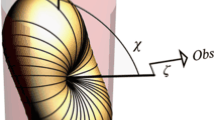Abstract
BECAUSE of the conjecture that pulsars are neutron stars, which are possibly produced in supernova events, the possible association of pulsars with supernova remnants is of great interest. Staelin and Reifenstein recently reported1 the discovery of two pulsed radio sources near the Crab nebula, which is the remnant of the supernova observed by the Chinese in AD 1054. Pulses from both sources were described as very sporadic, and no periodic phenomena were evident.
Similar content being viewed by others
References
IAU Circular No. 2110 (1968).
Lyne, A. G., and Rickett, B. J., Nature, 218, 934 (1968).
Staelin, D. H., and Reifenstein, E. C., Science (in the press).
Large, M. I., Vaughan, A. E., and Mills, B. Y., Nature, 220, 340 (1968).
Gold, T., Nature, 218, 73 (1968).
Hewish, A., and Okoye, S. E., Nature, 203, 171 (1964).
Author information
Authors and Affiliations
Rights and permissions
About this article
Cite this article
COMELLA, J., CRAFT, H., LOVELACE, R. et al. Crab Nebula Pulsar NP 0532. Nature 221, 453–454 (1969). https://doi.org/10.1038/221453a0
Received:
Issue Date:
DOI: https://doi.org/10.1038/221453a0
- Springer Nature Limited
This article is cited by
-
Evidence for three-dimensional spin–velocity alignment in a pulsar
Nature Astronomy (2021)
-
Radio Pulsars
Space Science Reviews (2015)
-
Morphology and characteristics of radio pulsars
The Astronomy and Astrophysics Review (2004)
-
Observation of stellar remnants from recent Supernovae
Nature (1984)





